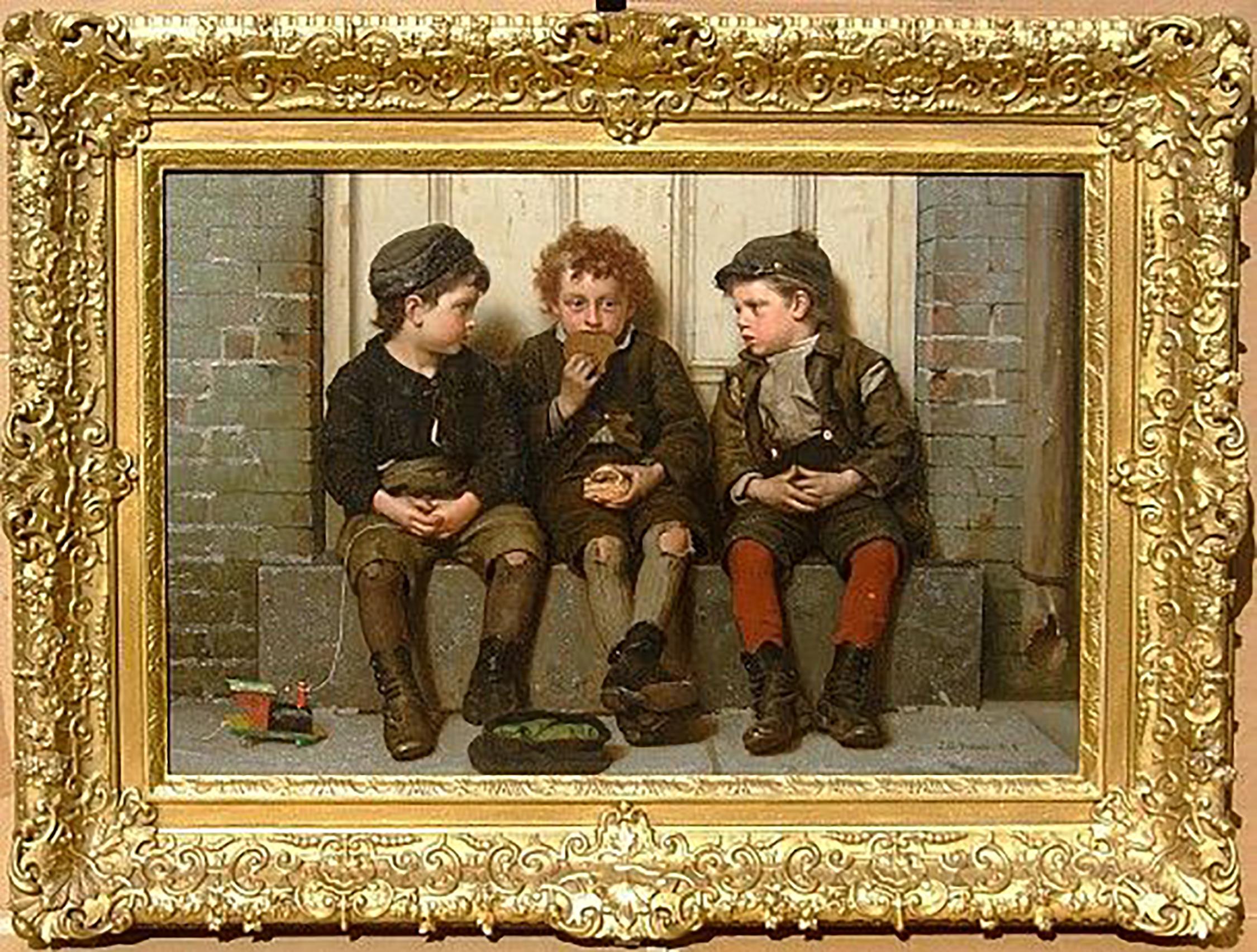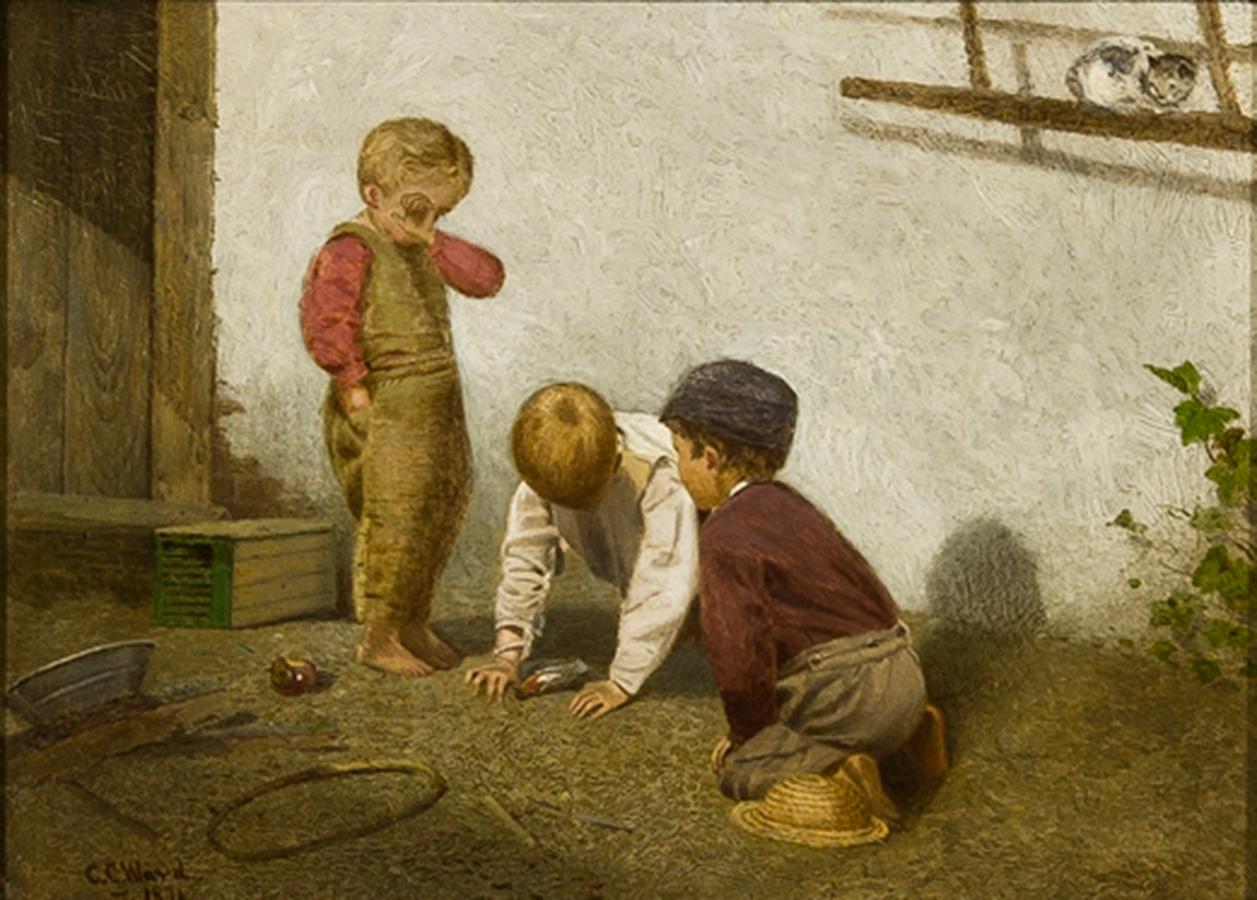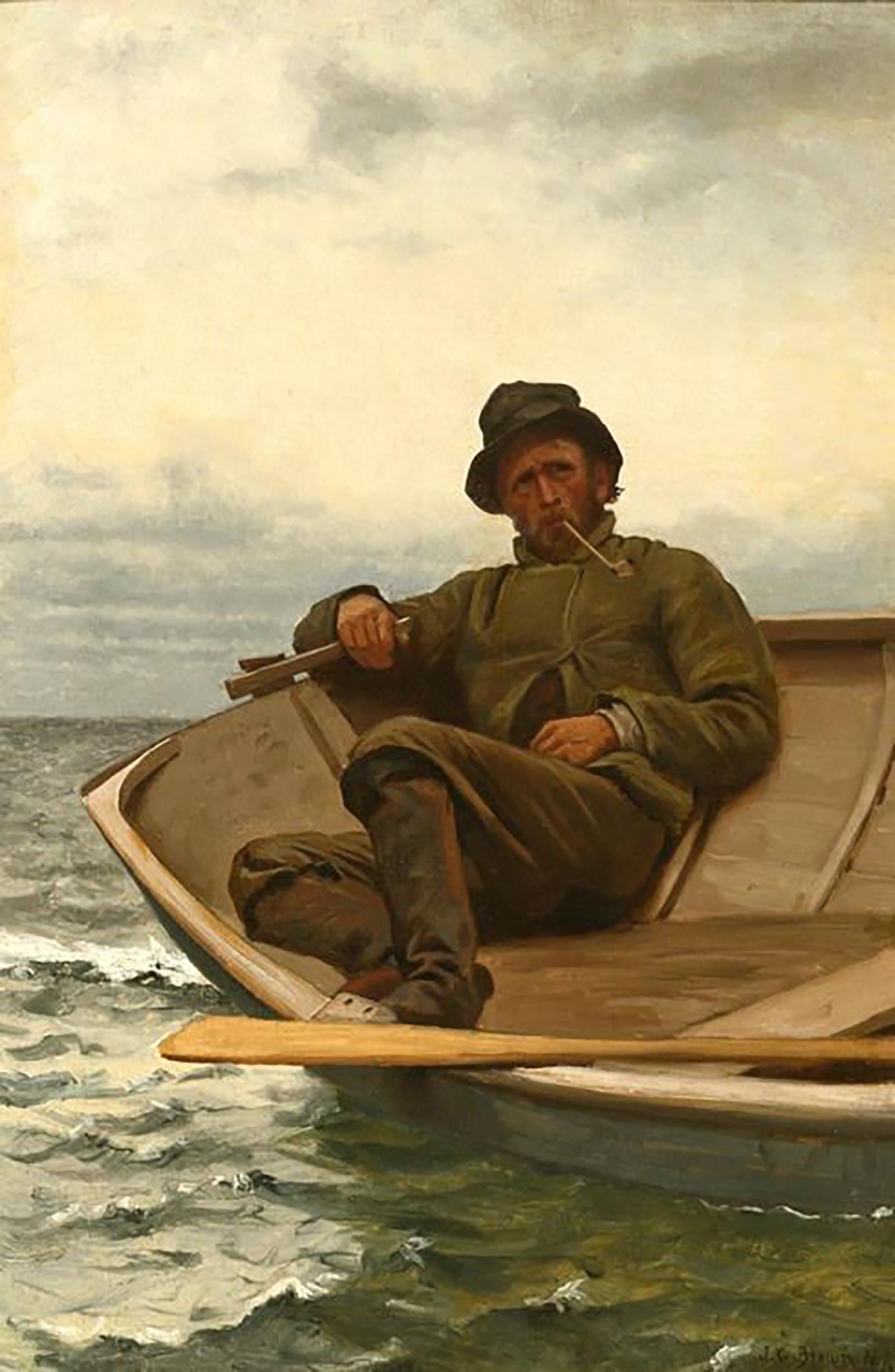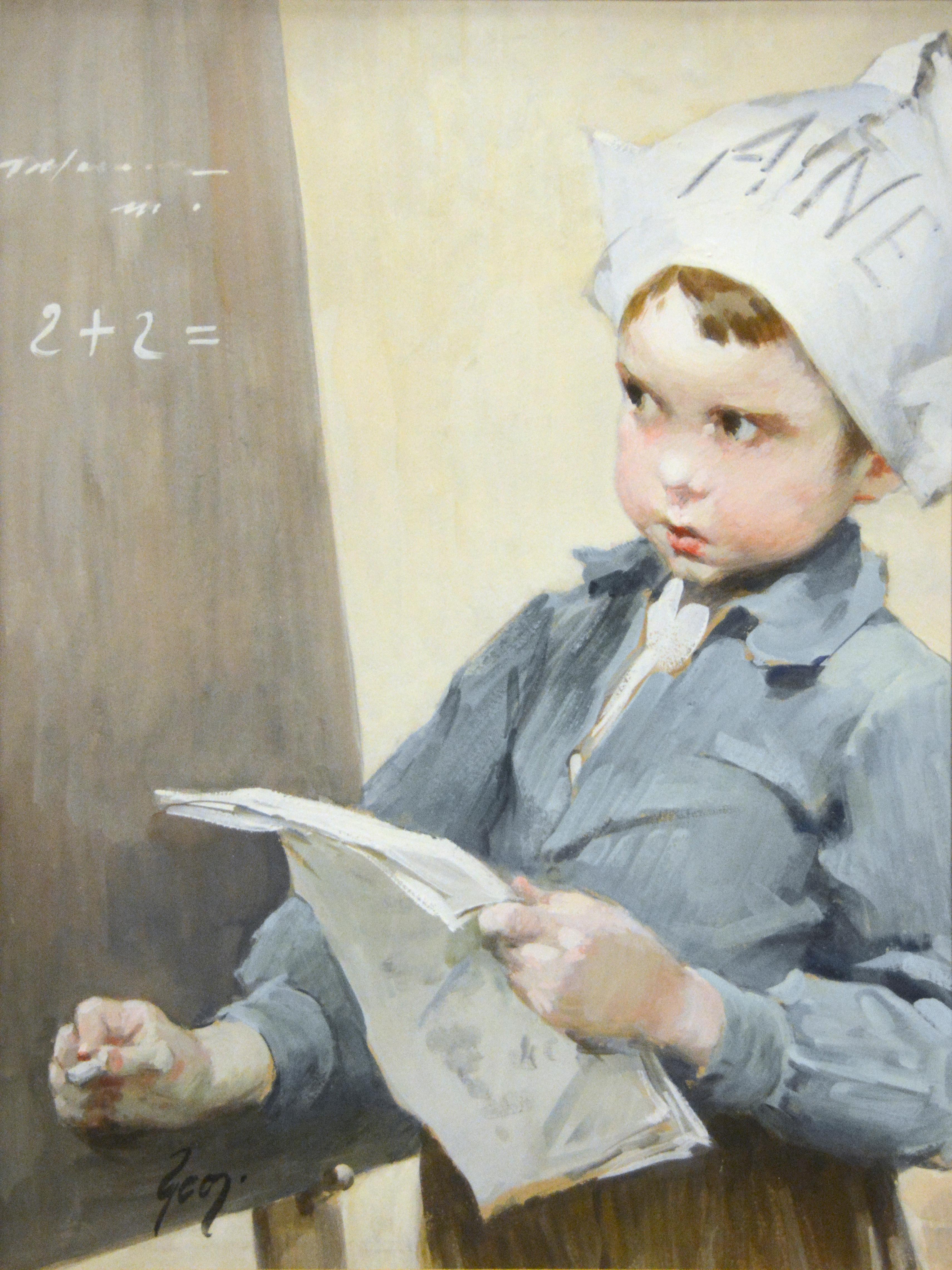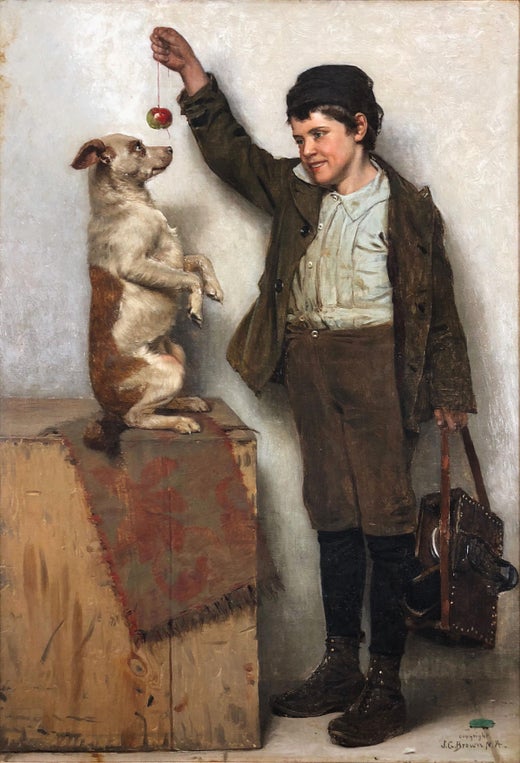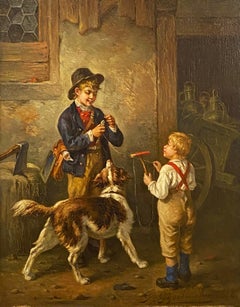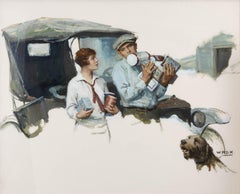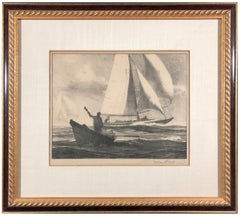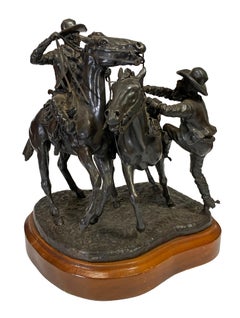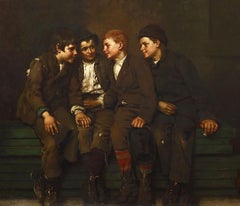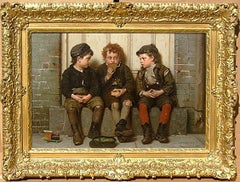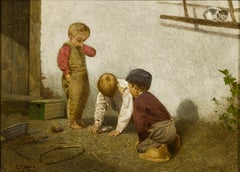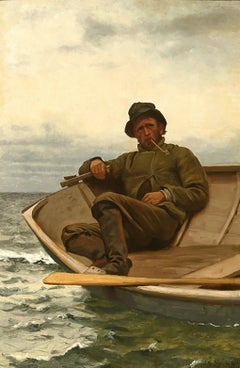Video Loading
Want more images or videos?
Request additional images or videos from the seller
1 of 8
John George BrownPreparing the Trick
$50,000
£38,179.06
€43,468.22
CA$70,207.88
A$76,750.97
CHF 40,604.72
MX$918,448.75
NOK 516,636.73
SEK 472,928.66
DKK 324,680.69
About the Item
Canvas Size: approx 26.5 x 18
Framed Size: approx 30 x 22 inches
Born into a poor family in Durham, England, John George Brown (1831-1913) earned a reputation as one of 19th-century America's most skilled painters of children, especially entrepreneurial, cheerful street urchins who earned a pittance as boot blacks, newspaper vendors, etc. In some circles, he was dubbed the "Boot Black Raphael" because of the glowing faces of his child figures and his skill of execution. His paintings of these sympathy-arousing children were so popular in a Victorian era of increased industrialization that he became rich from painting sales as well as royalties from lithographs.
Brown showed early drawing talent but was discouraged by his lawyer father who insisted that he learned a trade, so he apprenticed for seven years with a glass cutter at Newcastle-On-Tyne. He worked at this trade in Edinburgh, Scotland and attended the School of the Royal Scottish Academy under Robert Scott Lauder.
At age 22, he went to London and earned a living painting portraits. Inspired by a music hall performer singing about the fascination of American life, he emigrated to Brooklyn and supported himself as a glass cutter at the Flint Glass Works in Brooklyn. His designs so impressed his employer that he helped Brown study in New York with miniaturist Thomas Cummings whose daughter Brown married.
He studied art at night at the National Academy of Design, and in May, 1856, rented his first studio, which was located in Brooklyn. In 1860, he began painting his signature portraits and juvenile figures, and in 1863, he was elected a member of the National Academy of Design. He also served as a teacher at the Academy where his classes were very popular.
To escape the pressure of his buying public and pursue other talents, he painted landscapes, some of them rural scenes including the White Mountains of New Hampshire and the Hudson River Valley with treatment of light and shadow, in the style of Albert Bierstadt and Worthington Whittredge. One of his exhibition venues was the California State Fair in 1881 and 1884.
Source:
Michael David Zellman, "300 Years of American Art"
Peter Falk, "Who Was Who in American Art"
Edan Hughes, "Artists in California, 1786-1940"
- Creator:John George Brown (1831-1913, American)
- Dimensions:Height: 26.5 in (67.31 cm)Width: 18 in (45.72 cm)
- Medium:
- Movement & Style:
- Period:
- Condition:
- Gallery Location:Missouri, MO
- Reference Number:1stDibs: LU747316153552
John George Brown
John George Brown was born in 1831 near Durham, England. At fourteen he began a seven-year apprenticeship as a glass-cutter in Newcastle-on-Tyne, studying at night with William Bell Scott at the School of Design. From 1852 to 18253 he worked at the Holyrood Glass Works, Edinburgh, studying evenings at the Trustees Academy with Robert Scott Lauder. In 1853 Brown spent the summer in London where he painted a few portraits before emigrating to the United States that fall. He settled in Brooklyn finding work at the Brooklyn Flint Glass Company. During this time he attended the free classes offered at the Graham Art School and later studied under Thomas Seir Cummings at the National Academy of Design. In 1855, Brown opened a studio as a portrait painter. Brown received the support of the art dealer, Samuel S. P. Avery, and John H. Sherwood, collector and builder of the Sherwood Studio Building in 1880, who encouraged his turning from portraits to children as subjects. In 1859 Brown was one of the founding members of the Brooklyn Art Society and in 1861 a founding member of the Brooklyn Art Association. He moved to New York in 1861 finding quarters in the Tenth Street Studio Building where he maintained a studio for the rest of his life. Brown began in 1858 to exhibit at the National Academy, a practice he continued every year, except 1871, until his death. He was elected an associate of the Academy in 1861, full member in 1863, and served as its vice-president from 1899-1904. After turning to genre scenes of the street children of New York City in the 1860s, he soon became famous and wealthy. Brown copyrighted many of his paintings that were often reproduced commercially as chromolithographs or photographic reproductions. In 1867 he was elected one of the original members of the American Watercolor Society and was its president from 1887-1904. Brown and the art dealer, John Snedecor, travelled to Europe in 1870, visiting both London and Paris. During the summer months, he often explored the rural areas of New York and Vermont, as well as Grand Manan Island in the Bay of Fundy.
About the Seller
5.0
Vetted Professional Seller
Every seller passes strict standards for authenticity and reliability
Established in 1970
1stDibs seller since 2017
156 sales on 1stDibs
Typical response time: Several days
- ShippingRetrieving quote...Shipping from: Missouri, MO
- Return Policy
More From This Seller
View AllReadying for Play
Located in Missouri, MO
Framed Size: 25.5 x 23 inches
Joseph Gyselinckx was born in 1817. He was a genre painter in Antwerp. The artist was a student of F. de Brakeleer. He had two paintings included in ...
Category
Late 19th Century Realist Figurative Paintings
Materials
Canvas, Oil
Price Upon Request
Returning from the General Store
By William Henry Dethlef Koerner
Located in Missouri, MO
Returning from the General Store
William Henry Dethlef Koerner (German, American, 1878-1938)
Oil on Panel
Signed Lower Right
24 x 30 inches
27 x 33 inches with frame
William Henry D...
Category
Early 20th Century American Modern Figurative Paintings
Materials
Oil, Panel
Work and Play
By Gordon Grant
Located in Missouri, MO
Gordan Hope Grant (1875-1962)
"Work and Play"
Lithograph
Signed in Pencil Lower Right
Image Size: 9 x 11.5 inches
Framed Size: approx 18 x 20.5 inches
Born in San Francisco, Gordon Grant is known for his etchings and paintings of marine subjects. He also painted portraits, streets, harbors, beaches and marines, and was an illustrator, whose work included pulp fiction* for Popular Detective magazine in the 1930s. Skilled with watercolor, Grant was honored many times by the American Watercolor Society*. Memberships included the Society of Illustrators*, Salmagundi Club*, Allied Artists of America*, New York Society of Painters, and American Federation of Artists*.
At age 13, he was sent to Scotland for schooling, and the four-month sail around Cape Horn remained a permanent influence on his career. He studied art in Heatherly and at the Lambeth School of Art* in London, and then in 1895, he became a staff artist for the San Francisco Examiner. The next year, he took the same type of job for the New York World and covered the Boer War for Harper's Weekly. He also worked for Puck magazine...
Category
Mid-20th Century American Realist Figurative Prints
Materials
Lithograph
Price Upon Request
Preparing to Ride
Located in Missouri, MO
Preparing to Ride
By. George B. Marks (American, 1923-1983)
Signed and Dated
Throughout his artistic career, George Marks’s work was always guided by the...
Category
1970s American Realist Figurative Sculptures
Materials
Bronze
Price Upon Request
Presenting the Bouquet
By Edmund Adler
Located in Missouri, MO
Canvas Size: approx. 22 x 27 inches
Framed Size: approx. 29 x 34 inches
Edmund Adler (Austrian) 1876-1965
Known for his naturalness in color and expression, the artist Edmund...
Category
Early 20th Century Realist Figurative Paintings
Materials
Canvas, Oil
Price Upon Request
The Reading Lesson
By Bernard Pothast
Located in Missouri, MO
Bernard Pothast
"The Reading Lesson"
Oil on Canvas
Signed Lower Right
25 x 30 inches
30.5 x 35.5 inches framed
Born in Belgium, Bernard Pothast travel...
Category
Late 19th Century Dutch School Figurative Paintings
Materials
Canvas, Oil
Price Upon Request
You May Also Like
The Confab
By John George Brown
Located in Fort Washington, PA
This charming scene of four boys sitting on a bench having a conversation is typical of the sentimentalized portrayals of street urchins that John George Brown...
Category
1880s Realist Figurative Paintings
Materials
Canvas, Oil, Board
The Monopolist
By John George Brown
Located in Fort Washington, PA
Framed Dimensions: 36.00" x 48.00"
Signature: Signed Lower Right
J.G Brown's "Monopolist" was listed in 1885's Spring Exhibit catalogue of M.A. It was displayed on a panel in The We...
Category
1880s Figurative Paintings
Materials
Canvas, Oil
Price Upon Request
His Only Pet
Located in New York, NY
Charles Caleb Ward was born in St. John, New Brunswick, Canada, the grandson of a New York Ward who had left for New Brunswick around the time of th...
Category
Late 19th Century American Realist Paintings
Materials
Oil, Board
Homeward Bound
By John George Brown
Located in Fort Washington, PA
Signature: Signed Lower Right
Homeward Bound is a product of John George Brown’s 1877 and 1878 trips to Grand Manan Island, off the coast of Maine in t...
Category
1870s Figurative Paintings
Materials
Canvas, Oil
Solving the Problem
By Henri Jules Jean Geoffroy
Located in Mc Lean, VA
Signed lower left
Category
Early 20th Century Realist Figurative Paintings
Materials
Paper, Watercolor
Peek-a-Boo
By Seymour Joseph Guy
Located in New York, NY
In the latter half of the nineteenth century and into the first decade of the twentieth, New York City art aficionados could count on finding recent work of Seymour Joseph Guy hanging on the walls of the city’s major galleries. Primarily a genre artist, but also a portraitist, between 1859 and 1908 Guy showed more than seventy works at the National Academy of Design. From 1871 to 1903 he contributed over seventy times to exhibitions at the Century Club. From 1864 to 1887, he sent about forty pictures to the Brooklyn Art Association. A good number of these works were already privately owned; they served as advertisements for other pictures that were available for sale. Some pictures were shown multiple times in the same or different venues. Guy was as easy to find as his canvases were omnipresent. Though he lived at first in Brooklyn with his family and then in New Jersey, from 1863 to his death in 1910 he maintained a studio at the Artist’s Studio Building at 55 West 10th Street, a location that was, for much of that period, the center of the New York City art world.
Guy’s path to a successful career as an artist was by no means smooth or even likely. Born in Greenwich, England, he was orphaned at the age of nine. His early interest in art was discouraged by his legal guardian, who wanted a more settled trade for the young man. Only after the guardian also died was Guy free to pursue his intention of becoming an artist. The details of Guy’s early training in art are unclear. His first teacher is believed to have been Thomas Buttersworth...
Category
19th Century American Realist Figurative Paintings
Materials
Canvas, Oil
$110,000
More Ways To Browse
Antique Cutter
19th Century Black And White Lithograph
Hudson Valley Antique
Antique Glass Cutter
Antique Flint Glass
Golightly Lisa
Gustav Bauhaus
Homer Simpson
Hopi Art Painting
Jacob Markiel
Jazz Painting Large
Jean Jacques Henner
John Golding Painting
John Julian
Lempicka Painting
London Blitz
Lonely Man
Marlboro Man


